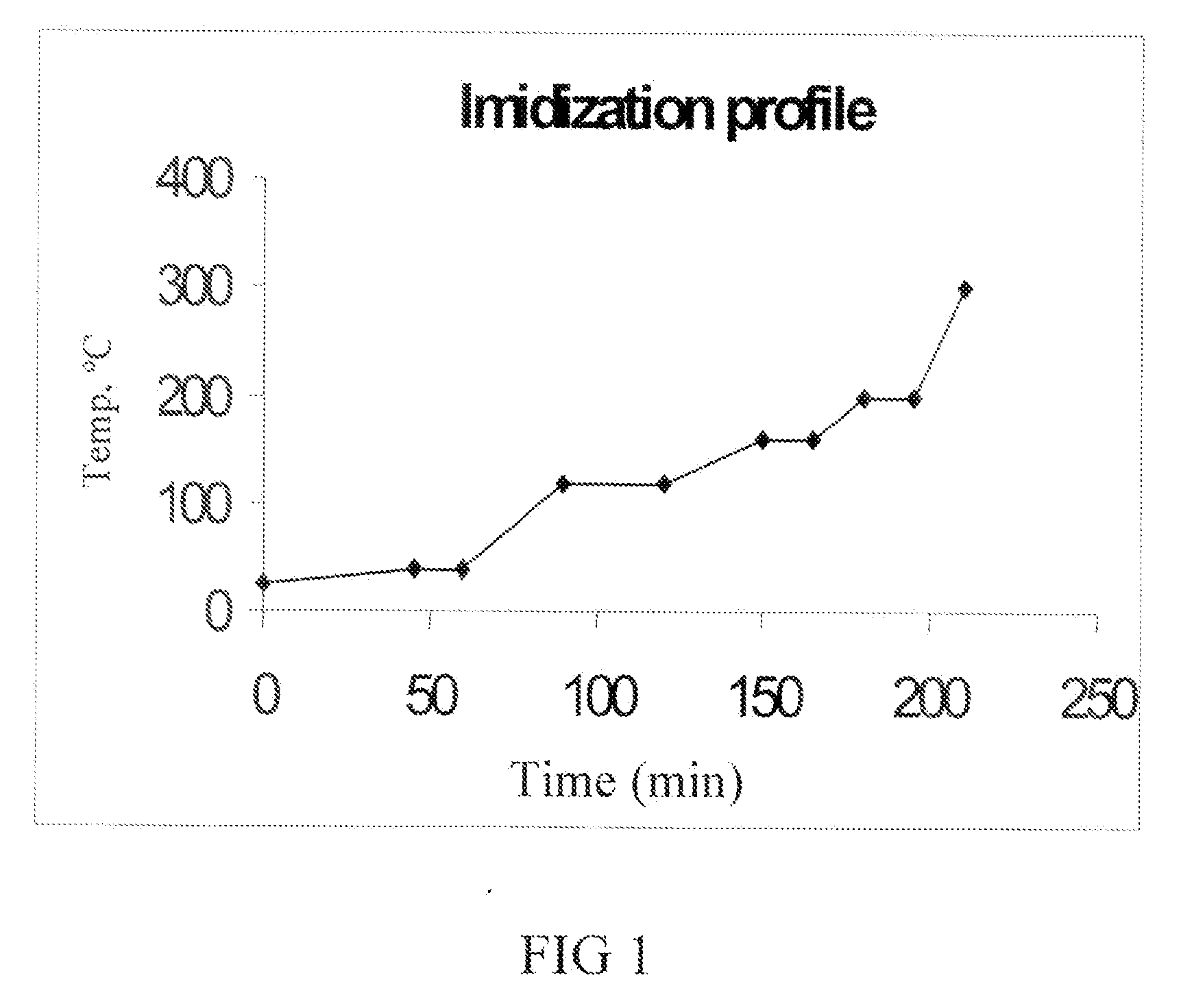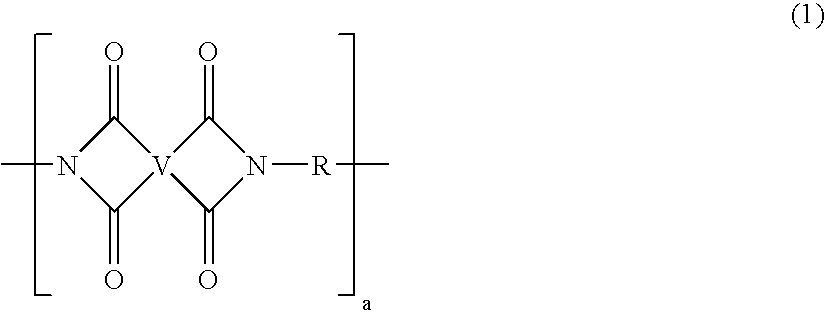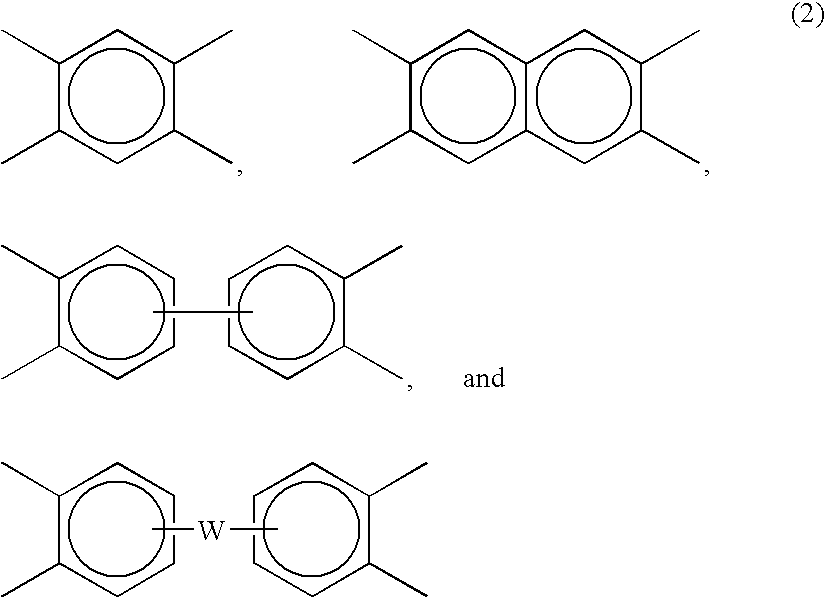Polyimide solvent cast films having a low coefficient of thermal expansion and method of manufacture thereof
a technology of solvent cast film and thermal expansion coefficient, which is applied in the field of solvent cast film comprising a polyimide, can solve the problems of film failing the tes
- Summary
- Abstract
- Description
- Claims
- Application Information
AI Technical Summary
Benefits of technology
Problems solved by technology
Method used
Image
Examples
examples
[0222]Without further elaboration, it is believed that the skilled artisan can, using the description herein, make and use the present invention. The following examples are included to provide additional guidance to those skilled in the art of practicing the claimed invention. These examples are provided as representative of the work and contribute to the teaching of the present invention. Accordingly, these examples are not intended to limit the scope of the present invention in any way. Unless otherwise specified below, all parts are by weight and all temperatures are in degrees Celsius.
Materials
[0223]ODPA is a dianhydride monomer also known as 4,4′-oxydiphthalic anhydride which can be made as described in U.S. Pat. No. 6,028,203, U.S. Pat. No. 4,870,194, or U.S. Pat. No. 5,021,168.
[0224]BPDA is a dianhydride monomer also known as 3,3′,4,4′-biphenyltetracarboxylic dianhydride which is commercially available from Chriskev Company, with offices in Leawood, Kans.
[0225]PMDA is a dianh...
examples 1-43
Film Casting Procedure and Experimental for Examples 1-43:
[0237]Inventive formulations 1-43 were prepared using the compositions specified in Table 1. The amounts of each monomer were calculated at a stoichiometry of 1 amine for every anhydride with no correction for purity, (corrections for purity can effect the final molecular weight of the polymer and could effect the final performance of the article). A Microsoft Excel spreadsheet calculator was constructed that calculates the grams of each monomer based upon the total grams polymer desired and the monomer feeds of dianhydride and amine. The skilled artisan will appreciate that there are many different ways of ascertaining the correct amount by weight of each ingredient to be used in making the films according to the present invention. It is within the ability of the skilled artisan to calculate the weight amount of ingredients based on the overall stoichiometry and the final percent solids of the reaction mechanism enunciated h...
example 44
Detailed Film Casting Example:
[0243]On an analytical balance, 0.5937 g (0.001914 mol) of 4,4′-oxydiphthalic anhydride and 0.4752 g (0.001914 mol) of 4,4′-diaminodiphenylsulfone were weighed out to be with in 0.0005 g of the desired weight. The monomers were transferred to a 20 mL scintillation vial, rinsing the weigh paper with 2.0 mL of dimethylacetamide, to ensure complete transfer of the monomers. The remaining solvent (5.47 mL of dimethylacetamide) was transferred by volumetric pipette to give a solution of 12.5 weight % solids. The vial was rendered inert by flowing nitrogen through the vial for one minute and then quickly capping the vial. The sample was then placed on the shaker overnight to form a poly(amic acid) solution.
[0244]Glass slides (Fisherbrand precleaned microscope slides) were cleaned with hexanes. The solution (2.0 mL) was then filtered through a 0.45 micrometer syringe tip filter onto a glass slide. The solution coated glass slide was then placed on a hotplate e...
PUM
| Property | Measurement | Unit |
|---|---|---|
| glass transition temperature | aaaaa | aaaaa |
| temperature | aaaaa | aaaaa |
| wt % | aaaaa | aaaaa |
Abstract
Description
Claims
Application Information
 Login to View More
Login to View More - R&D
- Intellectual Property
- Life Sciences
- Materials
- Tech Scout
- Unparalleled Data Quality
- Higher Quality Content
- 60% Fewer Hallucinations
Browse by: Latest US Patents, China's latest patents, Technical Efficacy Thesaurus, Application Domain, Technology Topic, Popular Technical Reports.
© 2025 PatSnap. All rights reserved.Legal|Privacy policy|Modern Slavery Act Transparency Statement|Sitemap|About US| Contact US: help@patsnap.com



